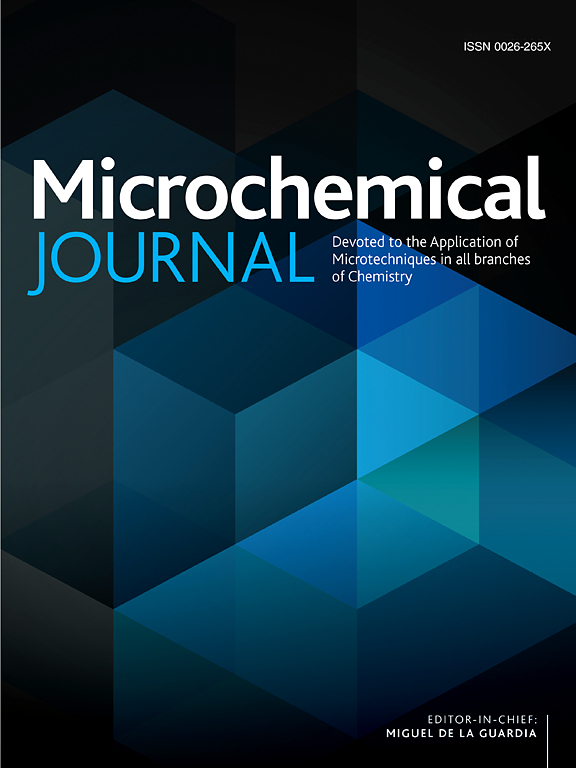基于固定化半胱硫氨酸β合酶(CBS)酶和Pd@CuO修饰共价有机框架的电化学传感器特异性检测同型半胱氨酸
IF 4.9
2区 化学
Q1 CHEMISTRY, ANALYTICAL
引用次数: 0
摘要
背景:同型半胱氨酸(Hcy)已被认为是心血管疾病发展的独立危险因素。目前已有许多电化学检测方法用于分析Hcy,但这些方法的特异性是基于Hcy中巯基与金属材料之间的相互作用,因此检测的特异性不理想。结果本研究建立了一种基于COFs和Pd@CuO的电化学传感器,用于Hcy的特异性检测。首先,将COFs材料作为半胱硫氨酸β-合成酶(CBS)的固定化载体,固定化CBS作为识别单元,能够以特定的方式催化底物(Hcy和Cys)产生H2S。其次,Pd@CuO复合材料具有优异的导电性,可以催化H2S作为电化学信号的来源。基于上述原理构建的电化学传感器在5 μM ~ 100 μM范围内对Hcy有良好的电化学响应,检出限可达0.11 μM (S/N = 3)。此外,所构建的传感器具有良好的再现性、稳定性和特异性,在真实血浆样品的检测中具有良好的回收率,为同型半胱氨酸血症的诊断提供了潜在的应用前景。意义与新颖性电化学传感器利用固定化Hcy特异催化酶CBS,显著提高了检测的特异性。此外,Pd修饰CuO@COFs电极大大增加了电极的导电性,从而提高了检测的灵敏度。这些特点使得电化学传感器在临床检测Hcy方面具有良好的应用前景。本文章由计算机程序翻译,如有差异,请以英文原文为准。
An electrochemical sensor based on immobilized cystathionine β-synthase (CBS) enzymes and Pd@CuO modified covalent organic framework for specific detection of homocysteine
Background
Homocysteine (Hcy) has been recognized as an independent risk factor for the development of cardiovascular disease. Many electrochemical detection methods have been developed for analyzing Hcy, however, the specificity of these methods is based on the interaction between the sulfhydryl groups in Hcy and the metallic materials, and thus the specificity of such detection is not satisfactory.
Results
In this study, an electrochemical sensor based on COFs and Pd@CuO was developed for the specific detection of Hcy. Firstly, COFs material was used as an immobilized carrier for cystathionine β-synthase (CBS), and the immobilized CBS as a recognition unit was able to catalyze the production of H2S from the substrates (Hcy and Cys) in a specific manner. Secondly, the Pd@CuO composite material has excellent conductivity and can catalyze H2S as a source of electrochemical signal generation. The electrochemical sensor constructed based on the above principles has a good electrochemical response to Hcy within the range of 5 μM to 100 μM, and the limit of detection can reach 0.11 μM (S/N = 3). In addition, the constructed sensor has good reproducibility, stability and specificity, and has good recoveries in the detection of real plasma samples, which provides a potential application for the diagnosis of homocysteinemia.
Significance and Novelty
The electrochemical sensor significantly increases the specificity of detection by utilizing immobilized Hcy specific catalytic enzymes CBS. In addition, Pd modified CuO@COFs electrode greatly increases the conductivity of the electrode, thereby increasing the sensitivity of detection. These characteristics make the electrochemical sensor have good application prospects for detecting the Hcy in clinic in the future.
求助全文
通过发布文献求助,成功后即可免费获取论文全文。
去求助
来源期刊

Microchemical Journal
化学-分析化学
CiteScore
8.70
自引率
8.30%
发文量
1131
审稿时长
1.9 months
期刊介绍:
The Microchemical Journal is a peer reviewed journal devoted to all aspects and phases of analytical chemistry and chemical analysis. The Microchemical Journal publishes articles which are at the forefront of modern analytical chemistry and cover innovations in the techniques to the finest possible limits. This includes fundamental aspects, instrumentation, new developments, innovative and novel methods and applications including environmental and clinical field.
Traditional classical analytical methods such as spectrophotometry and titrimetry as well as established instrumentation methods such as flame and graphite furnace atomic absorption spectrometry, gas chromatography, and modified glassy or carbon electrode electrochemical methods will be considered, provided they show significant improvements and novelty compared to the established methods.
 求助内容:
求助内容: 应助结果提醒方式:
应助结果提醒方式:


